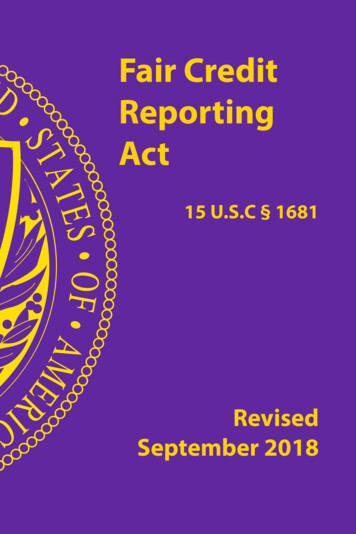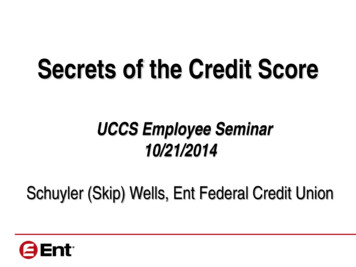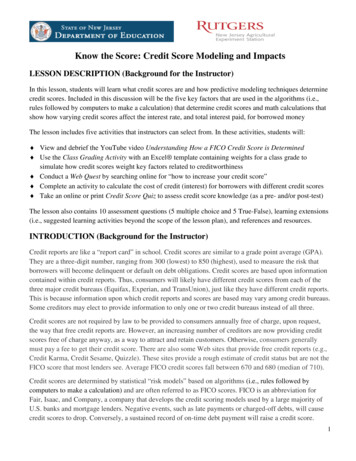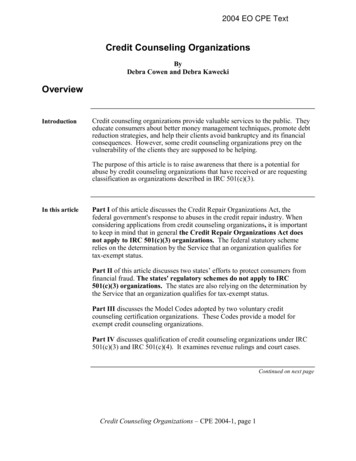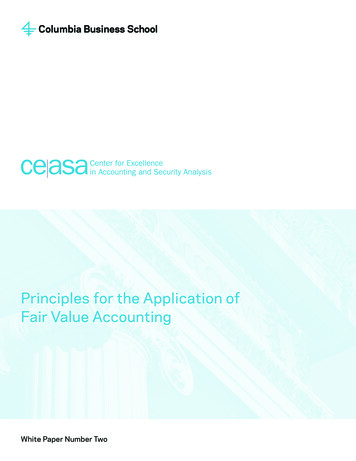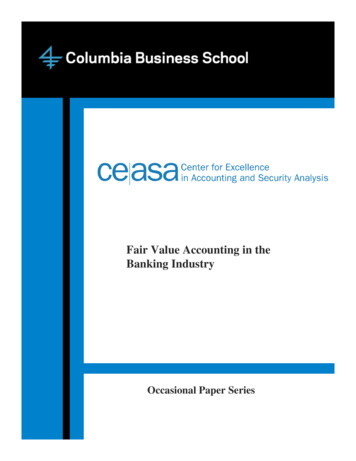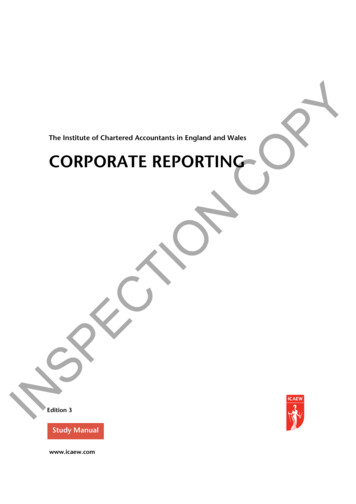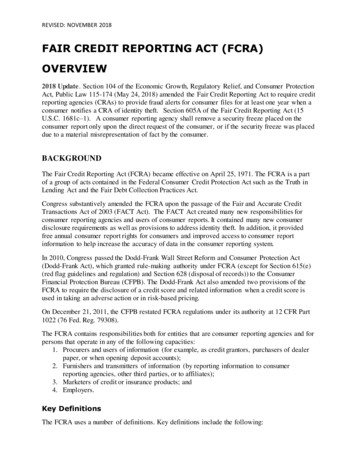
Transcription
REVISED: NOVEMBER 2018FAIR CREDIT REPORTING ACT (FCRA)OVERVIEW2018 Update. Section 104 of the Economic Growth, Regulatory Relief, and Consumer ProtectionAct, Public Law 115-174 (May 24, 2018) amended the Fair Credit Reporting Act to require creditreporting agencies (CRAs) to provide fraud alerts for consumer files for at least one year when aconsumer notifies a CRA of identity theft. Section 605A of the Fair Credit Reporting Act (15U.S.C. 1681c–1). A consumer reporting agency shall remove a security freeze placed on theconsumer report only upon the direct request of the consumer, or if the security freeze was placeddue to a material misrepresentation of fact by the consumer.BACKGROUNDThe Fair Credit Reporting Act (FCRA) became effective on April 25, 1971. The FCRA is a partof a group of acts contained in the Federal Consumer Credit Protection Act such as the Truth inLending Act and the Fair Debt Collection Practices Act.Congress substantively amended the FCRA upon the passage of the Fair and Accurate CreditTransactions Act of 2003 (FACT Act). The FACT Act created many new responsibilities forconsumer reporting agencies and users of consumer reports. It contained many new consumerdisclosure requirements as well as provisions to address identity theft. In addition, it providedfree annual consumer report rights for consumers and improved access to consumer reportinformation to help increase the accuracy of data in the consumer reporting system.In 2010, Congress passed the Dodd-Frank Wall Street Reform and Consumer Protection Act(Dodd-Frank Act), which granted rule-making authority under FCRA (except for Section 615(e)(red flag guidelines and regulation) and Section 628 (disposal of records)) to the ConsumerFinancial Protection Bureau (CFPB). The Dodd-Frank Act also amended two provisions of theFCRA to require the disclosure of a credit score and related information when a credit score isused in taking an adverse action or in risk-based pricing.On December 21, 2011, the CFPB restated FCRA regulations under its authority at 12 CFR Part1022 (76 Fed. Reg. 79308).The FCRA contains responsibilities both for entities that are consumer reporting agencies and forpersons that operate in any of the following capacities:1. Procurers and users of information (for example, as credit grantors, purchasers of dealerpaper, or when opening deposit accounts);2. Furnishers and transmitters of information (by reporting information to consumerreporting agencies, other third parties, or to affiliates);3. Marketers of credit or insurance products; and4. Employers.Key DefinitionsThe FCRA uses a number of definitions. Key definitions include the following:
REVISED: NOVEMBER 2018Adverse Action. With regard to credit transactions, the term “adverse action” has the samemeaning as used in Section 701(d)(6) [15 U.S.C. 1691(d)(6)] of the Equal Credit OpportunityAct (ECOA), Regulation B, and the official staff commentary. Under the ECOA, it means adenial or revocation of credit, a change in the terms of an existing credit arrangement, or arefusal to grant credit in substantially the same amount or on terms substantially similar to thoserequested. Under the ECOA, the term does not include a refusal to extend additional creditunder an existing credit arrangement where the applicant is delinquent or otherwise in default, orwhere such additional credit would exceed a previously established credit limit.For non-credit transactions, the term has the following additional meanings for purposes of theFCRA:1. a denial or cancellation of, an increase in any charge for, or a reduction or other adverse orunfavorable change in the terms of coverage or amount of, any insurance, existing or applied for,in connection with the underwriting of insurance;2. a denial of employment or any other decision for employment purposes that adversely affectsany current or prospective employee;3. a denial or cancellation of, an increase in any charge for, or any other adverse or unfavorablechange in the terms of, any license or benefit described in Section 604(a)(3)(D) (15 U.S.C.1681b(a)(3)(D)); and4. an action taken or determination that is:a. Made in connection with an application made by, or transaction initiated by, any consumeror in connection with a review of an account to determine whether the consumer continues tomeet the terms of the account.b. Adverse to the interests of the consumer.Consumer. A “consumer” is defined as an individual.Consumer Report. A “consumer report” is any written, oral, or other communication of anyinformation by a consumer reporting agency that bears on a consumer’s creditworthiness, creditstanding, credit capacity, character, general reputation, personal characteristics, or mode of livingthat is used or expected to be used or collected, in whole or in part, for the purpose of serving asa factor in establishing the consumer’s eligibility for any of the following:1. credit or insurance to be used primarily for personal, family, or household purposes;2. employment purposes; or3. any other purpose authorized under Section 604 (15 U.S.C. 1681b).
REVISED: NOVEMBER 2018Consumer Reporting Agency. The term “consumer reporting agency” means any person who,for monetary fees, dues, or on a cooperative nonprofit basis, regularly engages in whole or inpart in the practice of assembling or evaluating consumer credit information or otherinformation on consumers for the purpose of furnishing consumer reports to third parties, andwho uses any means or facility of interstate commerce for the purpose of preparing or furnishingconsumer reports.Credit Score. The term “credit score” means a numerical value or a categorization derived froma statistical tool or modeling system used by a person who makes or arranges a loan to predictthe likelihood of certain credit behaviors, including default (and the numerical value or thecategorization derived from such analysis may also be referred to as a “risk predictor” or “riskscore”). The term does not include any mortgage score or rating of an automated underwritingsystem that considers one or more factors in addition to credit information, including the loan tovalue ratio, the amount of down payment, or the financial assets of a consumer; or any otherelements of the underwriting process or underwriting decision.Creditor. Generally in FCRA, the terms “credit” and “creditor” have the same meanings as insection 702 of ECOA (15 U.S.C. 1691a).Employment Purposes. The term “employment purposes” when used in connection with aconsumer report means a report used for the purpose of evaluating a consumer for employment,promotion, reassignment or retention as an employee.Investigative Consumer Report. An “investigative consumer report” means a consumer report orportion thereof in which information on a consumer’s character, general reputation, personalcharacteristics, or mode of living is obtained through personal interviews with neighbors, friends,or associates of the consumer reported on or with others with whom he is acquainted or who mayhave knowledge concerning any such items of information. However, such information does notinclude specific factual information on a consumer’s credit record obtained directly from acreditor of the consumer or from a consumer reporting agency when such information wasobtained directly from a creditor of the consumer or from the consumer.Person. A “person” means any individual, partnership, corporation, trust, estate, cooperative,association, government or governmental subdivision or agency, or other entity.Module 1 – Obtaining Consumer ReportsOverviewThe FCRA governs access to consumer reports to ensure that a prospective user of theinformation obtains it for permissible purposes and does not exploit it for illegitimate purposes.The FCRA requires any prospective user of a consumer report, for example, a lender, insurer,landlord, or employer, among others, to have a legally permissible purpose to obtain a report.Permissible Purposes of Consumer Reports – Section 604; 15 U.S.C. 1681b InvestigativeConsumer Reports – Section 606; 15 U.S.C. 1681dLegally Permissible Purposes. The FCRA allows a consumer reporting agency to furnish aconsumer report for the following circumstances and no other:
REVISED: NOVEMBER 20181. In response to a court order or Federal Grand Jury subpoena.2. In accordance with the written instructions of the consumer.3. To a person, including a financial institution, that the agency has reason to believe intends touse the report as information for any of the following reasons:a. In connection with a credit transaction involving the consumer (includes extending, reviewing,and collecting credit);b. For employment purposes;c. In connection with the underwriting of insurance involving the consumer;d. In connection with a determination of the consumer’s eligibility for a license or other benefitgranted by a governmental instrumentality that is required by law to consider an applicant’sfinancial responsibility;e. As a potential investor or servicer, or current insurer, in connection with a valuation of, or anassessment of the credit or prepayment risks associated with, an existing credit obligation;f. Otherwise has a legitimate business need for the information:i. In connection with a business transaction that the consumer initiates; orii. To review an account to determine whether the consumer continues to meet the terms ofthe account.iii. In response to a request by the head of a State or local child support enforcement agency(or authorized appointee) if the person certifies various information to the consumer reportingagency regarding the need to obtain the report. (Generally, this particular purpose does notimpact a person, such as a financial institution, that is not a consumer reporting agency.)Prescreened Consumer Reports. Users of consumer reports, such as financial institutions, mayobtain prescreened consumer reports to make firm offers of credit or insurance to consumers,unless the consumers elected to opt out of being included on prescreened lists. The FCRAcontains many requirements, including an opt-out notice requirement when prescreenedconsumer reports are used.Investigative Consumer Reports. Section 606 contains specific requirements for use of aninvestigative consumer report. This type of consumer report contains information about aconsumer’s character, general reputation, personal characteristics, or mode of living obtained inwhole or in part through personal interviews with neighbors, friends, or associates of theconsumer.Procedures. Given the preponderance of electronically available information and the growth ofidentity theft, a user should manage the risks associated with obtaining and using consumerreports. Users should employ procedures, controls, or other safeguards to ensure that they obtainand use consumer reports only in situations for which there are permissible purposes.
REVISED: NOVEMBER 2018Module 2 – Obtaining Information and SharingAmong AffiliatesOverviewThe FCRA contains many substantive compliance requirements for consumer reporting agenciesdesigned to help ensure the accuracy and integrity of the consumer reporting system. As noted inthe definitions section, a consumer reporting agency is a person that generally furnishesconsumer reports to third parties. By their very nature, such third parties as banks, credit unions,and other financial institutions have a significant amount of consumer information that couldconstitute a consumer report, and thus communication of this information could cause theinstitution to become a consumer reporting agency. The FCRA contains several exceptions thatenable parties, such as a financial institution, to communicate this type of information, withinstrict guidelines, without becoming a consumer reporting agency.Rather than containing strict information-sharing prohibitions, the FCRA creates a businessdisincentive such that if an entity shares consumer report information outside of the exceptions,then the institution is a consumer reporting agency and will be subject to the significant,substantive requirements of the FCRA applicable to those entities. Typically, an entity such as afinancial institution will structure its information sharing practices within the exceptions to avoidbecoming a consumer reporting agency. This examination module generally covers the variousinformation-sharing practices within these exceptions.Consumer Report and Information Sharing – Section 603(d); 15U.S.C. 1681a(d)Section 603(d) defines a consumer report to include information about a consumer such as thatwhich bears on a consumer’s creditworthiness, character, and capacity among other factors.Communication of this information may cause a person, including a financial institution, tobecome a consumer reporting agency. The statutory definition contains key exceptions to thisdefinition that enable persons to share this type of information under certain circumstances,without becoming consumer reporting agencies. Specifically, the term “consumer report” doesnot include:1. A report containing information solely as to transactions or experiences between the consumerand the person making the report. A person, including a financial institution, may shareinformation strictly related to its own transactions or experiences with a consumer (such as theconsumer’s payment history, or an account with the institution) with any third party, withoutregard to affiliation, without becoming a consumer reporting agency. The Privacy of ConsumerFinancial Information regulations that implement the Gramm-Leach-Bliley Act (GLBA) mayrestrict this type of information sharing because it meets the definition of nonpublic personalinformation under the Privacy regulations. Therefore, sharing it with nonaffiliated third partiesmay be subject to an opt-out notice under the privacy regulations. In turn, the FCRA may alsorestrict activities that the GLBA permits. For example, the GLBA permits a financial institutionto share a list of its customers and information such as their credit scores with another financial
REVISED: NOVEMBER 2018institution to jointly market or sponsor other financial products or services. This communicationmay be a consumer report under the FCRA and could potentially cause the sharing financialinstitution to become a consumer reporting agency.2. Communication of such transaction or experience information among persons, includingfinancial institutions related by common ownership or affiliated by corporate control.3. Communication of other information (for example, other than transaction or experienceinformation) among persons related by common ownership or affiliated by corporate control, if itis clearly and conspicuously disclosed to the consumer that the information will becommunicated among such entities, and before the information is initially communicated, theconsumer is given the opportunity to opt out of the communication. This allows a person, such asa financial institution, to share other information (that is, information other than its owntransaction and experience information) that could otherwise be a consumer report, withoutbecoming a consumer reporting agency under both of the following circumstances:a. The sharing of the “other” information is done with affiliates.b. Consumers are provided with the notice and an opportunity to opt out of this sharing beforethe information is first communicated among affiliates.For example, “other” information can include information a consumer provides on anapplication form concerning accounts with other financial institutions. It can also includeinformation a financial institution obtains from a consumer reporting agency, such as theconsumer’s credit score. If a financial institution shares other information with affiliateswithout providing a notice and an opportunity to opt out, the financial institution may becomea consumer reporting agency subject to all of the other requirements of the FCRA. The optout right required by this section must be contained in a financial institution’s Privacy Noticeas required by GLBA and its implementing regulations.Other ExceptionsSpecific Extensions of Credit. In addition, the term consumer report does not include thecommunication of a specific extension of credit directly or indirectly by the issuer of a creditcard or similar device. For example, this exception allows a lender to communicate anauthorization through the credit card network to a retailer, to enable a consumer to complete apurchase using a credit card.Credit Decision to Third Party (for example, auto dealer). The term consumer report also doesnot include any report in which a person, including a financial institution, who has beenrequested by a third party to make a specific extension of credit directly or indirectly to aconsumer, conveys the decision with respect to the request. The third party must advise theconsumer of the name and address of the person, such as a financial institution, to which therequest was made, and such person makes the adverse action disclosures required by Section 615of the FCRA. For example, this exception allows a lender to communicate a credit decision to anautomobile dealer who is arranging financing for a consumer purchasing an automobile and whorequires a loan to finance the transaction.
REVISED: NOVEMBER 2018“Joint User” Rule. The Federal Trade Commission (FTC) staff commentary discusses anotherexception known as the “Joint User Rule.” Under this exception, users of consumer reports,including financial institutions, may share information if they are jointly involved in the decisionto approve a consumer’s request for a product or service, provided that each has a permissiblepurpose to obtain a consumer report on the individual. For example, a consumer applies for amortgage loan that will have a high loan-to-value ratio, and thus the lender will require privatemortgage insurance (PMI) in order to approve the application. An outside company provides thePMI. The lender and the PMI company can share consumer report information about theconsumer because both entities have permissible purposes to obtain the information and both arejointly involved in the decision to grant the products to the consumer. This exception applies toentities that are affiliated or nonaffiliated third parties. It is important to note that the GLBA willstill apply to the sharing of nonpublic, personal information with nonaffiliated third parties;therefore, a person, such as a financial institution, should be aware the GLBA may still limit orprohibit sharing allowed under the FCRA joint user rule.Protection of Medical Information – Section 604(g); 15 U.S.C.1681b(g);12 CFR 1022, Subpart DSection 604(g) generally prohibits creditors from obtaining and using medical information inconnection with any determination of the consumer’s eligibility, or continued eligibility, forcredit. The statute contains no prohibition on creditors obtaining or using medical informationfor other purposes that are not in connection with a determination of the consumer’s eligibility,or continued eligibility for credit.Section 604(g)(5)(A) requires the federal banking agencies and NCUA to prescribe regulationsthat permit transactions that are determined to be necessary and appropriate to protect legitimateoperational, transactional, risk, consumer, and other needs (including administrative verificationpurposes), consistent with the Congressional intent to restrict the use of medical information forinappropriate purposes. On November 22, 2005, the FFIEC Agencies published final rules in theFederal Register (70 FR 70664). The rules contain the general prohibition on obtaining or usingmedical information, and provide exceptions for the limited circumstances when medicalinformation may be used. The rules define “credit” and “creditor” as having the same meaningsas in Section 702 of the ECOA (15 U.S.C. 1691a). On December 21, 2011, the CFPB restatedthe implementing regulation at 12 CFR Part 1022 (76 Fed. Reg. 79308).Obtaining and Using Unsolicited Medical Information (12 CFR 1022.30(c)). A creditor does notviolate the prohibition on obtaining medical information if it receives the medical informationpertaining to a consumer in connection with any determination of the consumer’s eligibility, orcontinued eligibility, for credit without specifically requesting medical information. However,the creditor may only use this medical information in connection with a determination of theconsumer’s eligibility, or continued eligibility, for credit in accordance with either the financialinformation exception or one of the specific other exceptions provided in the rules. We discussthese exceptions below.
REVISED: NOVEMBER 2018Financial Information Exception (12 CFR 1022.30(d)). The rules allow a creditor to obtain anduse medical information pertaining to a consumer in connection with any determination of theconsumer’s eligibility or continued eligibility for credit, so long as:1. The information is the type of information routinely used in making credit eligibilitydeterminations, such as information relating to debts, expenses, income, benefits, assets,collateral, or the purpose of the loan, including the use of the loan proceeds.2. The creditor uses the medical information in a manner and to an extent that is no lessfavorable than it would use comparable information that is not medical information in a credittransaction.3. The creditor does not take the consumer’s physical, mental, or behavioral health, condition orhistory, type of treatment, or prognosis into account as part of any such determination.The financial information exception is designed in part to allow creditors to consider aconsumer’s medical debts and expenses in the assessment of that consumer’s ability to repay theloan according to the loan terms. In addition, the financial information exception also allows acreditor to consider the dollar amount and continued eligibility for disability income, worker’scompensation income, or other benefits related to health or a medical condition that is relied onas a source of repayment.The creditor may use the medical information in a manner and to an extent that is no lessfavorable than it would use comparable, nonmedical information. For example, a consumerincludes on an application for credit information about two 20,000 debts. One debt is to ahospital; the other is to a retailer. The creditor may use and consider the debt to the hospital inthe same manner in which it considers the debt to the retailer, such as including the debts in thecalculation of the consumer’s proposed debt-to-income ratio. In addition, the consumer’spayment history of the debt to the hospital may be considered in the same manner as the debt tothe retailer. For example, if the creditor does not grant loans to applicants who have debts thatare 90-days past due, the creditor could consider the past-due status of a debt to the hospital, inthe same manner as the past-due status of a debt to the retailer.A creditor may use medical information in a manner that is more favorable to the consumer,according to its regular policies and procedures. For example, if a creditor has a routine policy ofdeclining consumers who have a 90-day past due installment loan to a retailer, but does notdecline consumers who have a 90-day past due debt to a hospital, the financial informationexception would allow a creditor to continue this policy without violating the rules because inthese cases, the creditor’s treatment of the debt to the hospital is more favorable to the consumer.A creditor may not take the consumer’s physical, mental, or behavioral health, condition orhistory, type of treatment, or prognosis into account as part of any determination regarding theconsumer’s eligibility, or continued eligibility for credit. The creditor may only consider thefinancial implications as discussed above, such as the status of a debt to a hospital, continuedeligibility for disability income, etc.Specific Exceptions for Obtaining and Using Medical Information (12 CFR 1022.30(e)). Inaddition to the financial information exception, the rules also provide for the following nine
REVISED: NOVEMBER 2018specific exceptions under which a creditor can obtain and use medical information in itsdetermination of the consumer’s eligibility, or continued eligibility for credit:1. To determine whether the use of a power of attorney or legal representative that is triggered bya medical condition or event is necessary and appropriate, or whether the consumer has the legalcapacity to contract when a person seeks to exercise a power of attorney or act as a legalrepresentative for a consumer based on an asserted medical condition or event. For example, ifPerson A is attempting to act on behalf of Person B under a Power of Attorney that is invokedbased on a medical event, a creditor is allowed to obtain and use medical information to verifythat Person B has experienced a medical condition or event such that Person A is allowed to actunder the Power of Attorney.2. To comply with applicable requirements of local, state, or Federal laws.3. To determine, at the consumer’s request, whether the consumer qualifies for a legallypermissible special credit program or credit-related assistance program that is:a. Designed to meet the special needs of consumers with medical conditions andb. Established and administered pursuant to a written plan that:i. Identifies the class of persons that the program is designed to benefit; andii. Sets forth the procedures and standards for extending credit or providing other creditrelated assistance under the program.4. To the extent necessary for purposes of fraud prevention or detection.5. In the case of credit for the purpose of financing medical products or services, to determineand verify the medical purpose of the loan and the use of the proceeds.6. Consistent with safe and sound banking practices, if the consumer or the consumer’s legalrepresentative requests that the creditor use medical information in determining the consumer’seligibility, or continued eligibility, for credit, to accommodate the consumer’s particularcircumstances, and such request is documented by the creditor. For example, at the consumer’srequest, a creditor may grant an exception to its ordinary policy to accommodate a medicalcondition that the consumer has experienced. This exception allows a creditor to considermedical information in this context, but it does not require a creditor to make such anaccommodation nor does it require a creditor to grant a loan that is unsafe or unsound.7. Consistent with safe and sound practices, to determine whether the provisions of a forbearancepractice or program that is triggered by a medical condition or event apply to a consumer. Forexample, if a creditor has a policy of delaying foreclosure in cases where a consumer isexperiencing a medical hardship, this exception allows the creditor to use medical information todetermine if the policy would apply to the consumer. Like the exception listed in the bulletabove, this exception does not require a creditor to grant forbearance, it merely provides anexception so that a creditor may consider medical information in these instances.
REVISED: NOVEMBER 20188. To determine the consumer’s eligibility for the triggering of, or the reactivation of a debtcancellation contract or debt suspension agreement, if a medical condition or event is a triggeringevent for the provision of benefits under the contract or agreement.9. To determine the consumer’s eligibility for the triggering of, or the reactivation of a creditinsurance product, if a medical condition or event is a triggering event for the provision ofbenefits under the product.Limits on redisclosure of information (12 CFR 1022.31(b)). If a creditor subject to the medicalinformation rules receives medical information about a consumer from a consumer reportingagency or its affiliate, the creditor must not disclose that information to any other person, exceptas necessary to carry out the purpose for which the information was initially disclosed, or asotherwise permitted by statute, regulation, or order.Sharing medical information with affiliates (12 CFR 1022.32(b)). In general, the exclusions fromthe definition of “consumer report” in Section 603(d)(2) of the FCRA allow the sharing of nonmedical information among affiliates. With regard to medical information, Section 603(d) (3) ofthe FCRA provides that the exclusions in Section 603(d)(2) do not apply when a person subjectto the medical information rules shares any of the following information with an affiliate:1. Medical information.2. An individualized list or description based on the payment transactions of the consumer formedical products or services.3. An aggregate list of identified consumers based on payment transactions for medical productsor services. If a person who is subject to the medical rules shares with an affiliate the type ofinformation discussed above, the exclusions from the definition of “consumer report” do notapply. Effectively, this means that if a person shares medical information, that person becomes aconsumer reporting agency, subject to all of the other substantive requirements of the FCRA.The rules provide exceptions to these limitations on sharing medical information with affiliates(12 CFR 1022.32(c)). A person, such as a bank, thrift, or credit union, may share medicalinformation with its affiliates without becoming a consumer reporting agency under any of thefollowing circumstances:1. In connection with the business of insurance or annuities (including the activities described inSection 18B of the model Privacy of Consumer Financial and Health Information Regulationissued by the National Association of Insurance Commissioners, as in effect on January 1, 2003).2. For any purpose permitte
consumer reports are used. Investigative Consumer Reports. Section 606 contains specific requirements for use of an investigative consumer report. This type of consumer report contains information about a consumer’s character, general reputation

